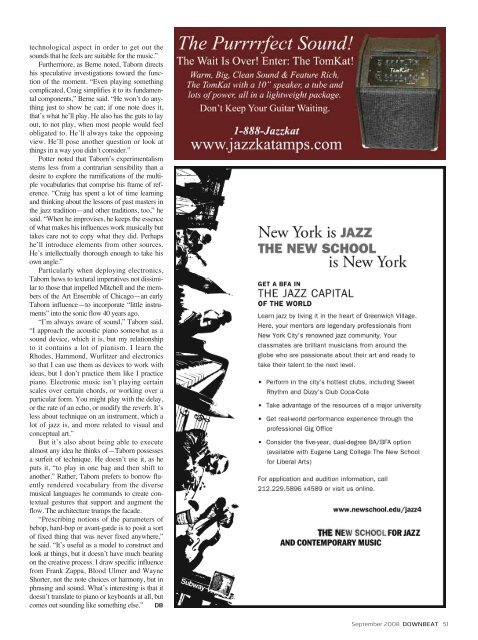Download - Downbeat
Download - Downbeat
Download - Downbeat
Create successful ePaper yourself
Turn your PDF publications into a flip-book with our unique Google optimized e-Paper software.
technological aspect in order to get out the<br />
sounds that he feels are suitable for the music.”<br />
Furthermore, as Berne noted, Taborn directs<br />
his speculative investigations toward the function<br />
of the moment. “Even playing something<br />
complicated, Craig simplifies it to its fundamental<br />
components,” Berne said. “He won’t do anything<br />
just to show he can; if one note does it,<br />
that’s what he’ll play. He also has the guts to lay<br />
out, to not play, when most people would feel<br />
obligated to. He’ll always take the opposing<br />
view. He’ll pose another question or look at<br />
things in a way you didn’t consider.”<br />
Potter noted that Taborn’s experimentalism<br />
stems less from a contrarian sensibility than a<br />
desire to explore the ramifications of the multiple<br />
vocabularies that comprise his frame of reference.<br />
“Craig has spent a lot of time learning<br />
and thinking about the lessons of past masters in<br />
the jazz tradition—and other traditions, too,” he<br />
said. “When he improvises, he keeps the essence<br />
of what makes his influences work musically but<br />
takes care not to copy what they did. Perhaps<br />
he’ll introduce elements from other sources.<br />
He’s intellectually thorough enough to take his<br />
own angle.”<br />
Particularly when deploying electronics,<br />
Taborn hews to textural imperatives not dissimilar<br />
to those that impelled Mitchell and the members<br />
of the Art Ensemble of Chicago—an early<br />
Taborn influence—to incorporate “little instruments”<br />
into the sonic flow 40 years ago.<br />
“I’m always aware of sound,” Taborn said.<br />
“I approach the acoustic piano somewhat as a<br />
sound device, which it is, but my relationship<br />
to it contains a lot of pianism. I learn the<br />
Rhodes, Hammond, Wurlitzer and electronics<br />
so that I can use them as devices to work with<br />
ideas, but I don’t practice them like I practice<br />
piano. Electronic music isn’t playing certain<br />
scales over certain chords, or working over a<br />
particular form. You might play with the delay,<br />
or the rate of an echo, or modify the reverb. It’s<br />
less about technique on an instrument, which a<br />
lot of jazz is, and more related to visual and<br />
conceptual art.”<br />
But it’s also about being able to execute<br />
almost any idea he thinks of—Taborn possesses<br />
a surfeit of technique. He doesn’t use it, as he<br />
puts it, “to play in one bag and then shift to<br />
another.” Rather, Taborn prefers to borrow fluently<br />
rendered vocabulary from the diverse<br />
musical languages he commands to create contextual<br />
gestures that support and augment the<br />
flow. The architecture trumps the facade.<br />
“Prescribing notions of the parameters of<br />
bebop, hard-bop or avant-garde is to posit a sort<br />
of fixed thing that was never fixed anywhere,”<br />
he said. “It’s useful as a model to construct and<br />
look at things, but it doesn’t have much bearing<br />
on the creative process. I draw specific influence<br />
from Frank Zappa, Blood Ulmer and Wayne<br />
Shorter, not the note choices or harmony, but in<br />
phrasing and sound. What’s interesting is that it<br />
doesn’t translate to piano or keyboards at all, but<br />
comes out sounding like something else.” DB<br />
September 2008 DOWNBEAT 51
















